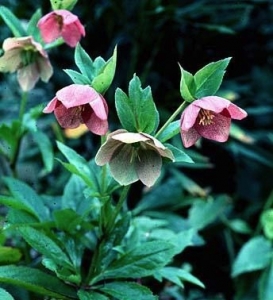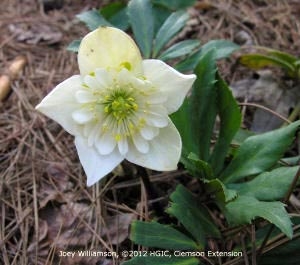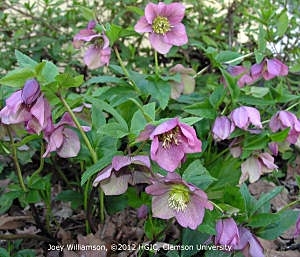Hellebores: Near-perfection in a Plant
Plants We Love
 By Marsha Goldberg, Fairfax Master Gardener
By Marsha Goldberg, Fairfax Master Gardener
In late winter, nothing sets gardeners’ hearts aflutter faster than seeing green sprouts shooting from the ground. That’s why so many gardeners love hellebores, one of the earliest plants to bloom in our region. The Perennial Plant Association voted hellebores the Perennial Plant of the Year for 2005, and we master gardeners agree: Hellebores are definitely plants worth having.
Often called Christmas Rose or Lenten Rose due to the time they bloom, hellebores show new growth even in the depth of winter. In fact, it is not uncommon to see their flowers capped by tiny mounds of snow. Such treatment does not bother them at all; hellebores bounce right back when the weather warms!
Despite the “rose” appellation, hellebores are not members of the rose family. Rather, they are kin to Ranunculaceae, or buttercups, and resemble these smaller-flowered cousins. There are 15 species of hellebores and a wide variety of cultivars, as they are easy to hybridize.

White, semi-double Lenten rose (Helleborus x hybridus)
As an added bonus, these herbaceous perennials are evergreen. Their thick, waxy leaves endure cold weather, turning brown and wilted just as the new growth begins to appear. Cutting back hellebores is optional, although doing so gives them a neater appearance. If you want to tidy them up, do it when you see new growth starting; otherwise, the fresh leaves will quickly obscure the previous year’s growth, making it harder to find and trim the older greenery.
Hellebores enjoy shade and blend easily with other shade-loving perennials such as hostas and ferns, which have contrasting leaf shapes. Deep shade, however, will result in fewer blooms and somewhat leggy plants. Hellebores can also tolerate partial sun. Their soil should be slightly acidic and moist but drain well. If your soil is mostly clay, adding compost, rotted manure or soil conditioner will help give plants a good start. As with peonies, you should not plant hellebores too deeply or pile on too much mulch. Hellebores can tolerate dry spells, and although they may wilt a bit, they will perk up after watering. Hellebores are both deer- and rabbit-resistant, and few diseases bother them.
 Seed pods appear once the flowers have faded; as seeds drop, the plant will self-sow. To yield additional plants, dig up and replant the small seedlings that emerge under the mother plant, or divide most species in the fall. Hellebores are slow-growers, so expect seedlings to take about three years to bloom and reach full size (12 to 18 inches tall). Because they are such slow-growers, purchasing hellebores can be expensive; most full-sized plants run $15 to $30, with unusual colors costing more. To save money, buy smaller plants, or replant your own seedlings. However you acquire them, hellebores make an outstanding addition to your garden, delivering a beautiful array of an almost perfect plant.
Seed pods appear once the flowers have faded; as seeds drop, the plant will self-sow. To yield additional plants, dig up and replant the small seedlings that emerge under the mother plant, or divide most species in the fall. Hellebores are slow-growers, so expect seedlings to take about three years to bloom and reach full size (12 to 18 inches tall). Because they are such slow-growers, purchasing hellebores can be expensive; most full-sized plants run $15 to $30, with unusual colors costing more. To save money, buy smaller plants, or replant your own seedlings. However you acquire them, hellebores make an outstanding addition to your garden, delivering a beautiful array of an almost perfect plant.
References & Resources
Lenten Rose, Clemson University Cooperative Extension (author)
Hellebore: The Lenten Rose, University of Vermont, L. Perry, Department of Plant and Soil Science. Undated
The Layered Garden, D. Culp, Levine, Portland, OR; Timber Press, Inc. 2012
Hellebores, Perry, L. University of Vermont, Department of Plant and Soil Science
Hellebores: A Comprehensive Guide, C. Burrell, & J. Tyler, (2006), Portland, OR; Timber Press, Inc.